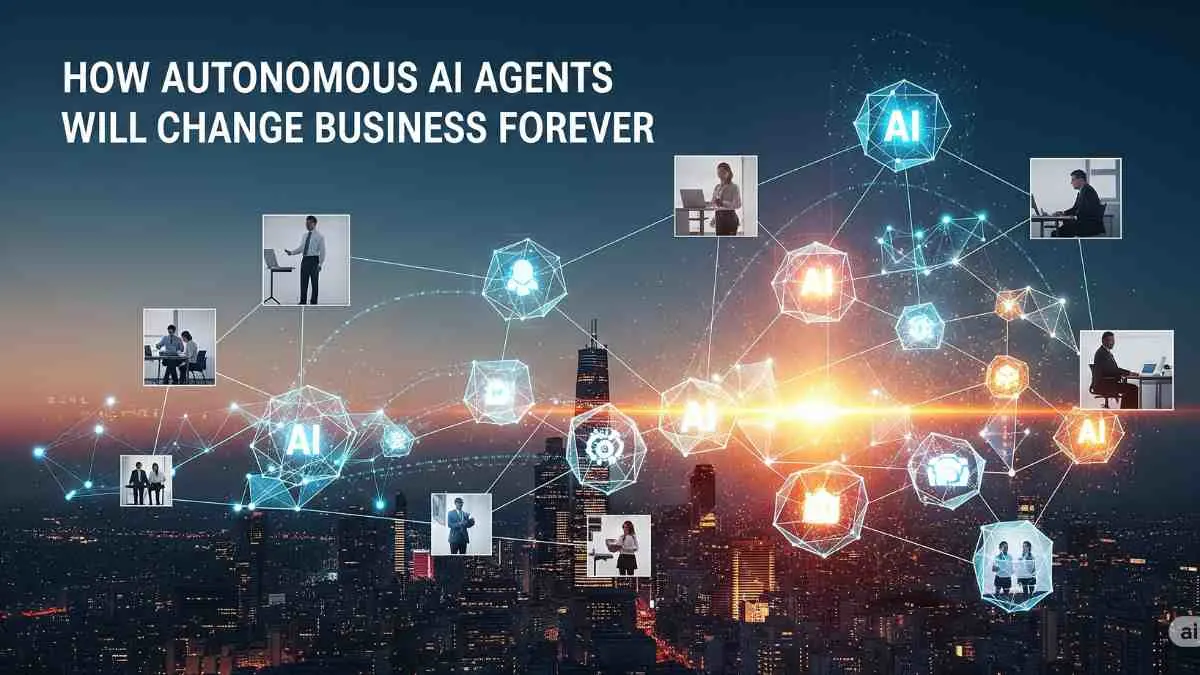Imagine stepping into your office one day and realizing daily tasks—emails, inventory, finances, marketing, support—are already completed before you even log in. The staff isn’t working overtime or chained to their desks; instead, the workload has been handled by invisible coworkers: autonomous AI agents. This isn’t science fiction or a corporate fantasy. It’s rapidly becoming the norm as businesses adopt and benefit from these intelligent, tireless agents.
In this in-depth blog, we’ll embark on a storytelling journey through the evolving landscape of AI, practical applications, industry trends, challenges, opportunities, and a future where humans and AI collaborate seamlessly. Along the way, you’ll encounter detailed analysis, case studies, and answers to frequently asked questions about autonomous AI agents for business.
Chapter 1: Once Upon a Business Day
Picture Ava, an AI agent “working” at Ecom Innovations, an online retailer. Ava’s not a person in an office, but a digital brain humming inside company systems. It’s 2AM. While employees sleep, Ava checks incoming orders, verifies payment, scans for fraud, and alerts the warehouse of items to ship.
At 7 AM, she’s already handled customer complaints, issued refunds, launched new campaigns, and adjusted product recommendations based on overnight customer trends.
Ava doesn’t take breaks. She doesn’t need coffee, sick leave, or vacation. Instead, she grows smarter every day, learning from each order and every customer interaction.
By the time human workers sign in, most routine work is done. They’re free to focus on fresh marketing ideas, negotiating with suppliers, or crafting expansion strategies. Ava seamlessly “passes the baton,” making everyone more effective.
Chapter 2: What Are Autonomous AI Agents?
Autonomous AI agents are self-directed software programs powered by sophisticated artificial intelligence. They don’t just follow predefined scripts. Instead, they:
- Make real-time decisions based on changing goals and data.
- Plan action sequences to achieve objectives (like optimizing inventory or responding to customer issues).
- Collaborate with other agents and software systems.
- Learn from every task, adapting to shifting business needs with machine learning.
- Work continuously, scaling operations far beyond human limits.
This isn’t simple automation. Traditional bots did repetitive tasks, but they couldn’t adjust to surprises or take initiative. Today’s AI agents are more like virtual employees: proactive, resourceful, and always on duty. Learn more about what makes AI agents special in this guide.
Chapter 3: Why Now? Timing the AI Revolution
The rapid acceleration of AI technology is transforming business. Improvements in natural language processing, decision-making, and cloud computing now enable even medium-sized businesses to leverage advanced AI. Competitive pressure is mounting. By the end of 2025, 25% of companies using AI will have autonomous agents in live projects. This figure is expected to double within two years.
We are at the dawn of an “invisible workforce” age, and everyone—from startups to Fortune 500 giants—is paying attention.
Chapter 4: Practical Uses—Real Stories from the Front Lines
Let’s journey through business departments to see where autonomous AI agents shine.
Customer Service
- Chatbots vs. AI Agents: While chatbots answer standard questions, AI agents (like Ava) handle tier 1 support, research custom answers, route escalations, and track customer sentiment. This means customers get instant help at any hour, and support teams spend time improving, not just firefighting.
- Results: Some companies have reduced support costs by 30% and cut response times from hours to seconds.
Sales & Marketing
- Personalization: AI agents study user behavior in real time, launching perfectly timed offers and email campaigns.
- Automation of Campaigns: They automate A/B testing, monitor KPIs, and adjust strategies on the fly based on what’s working.
- Result: Higher conversion rates, reduced “dead time,” and deeply targeted marketing.
Operations & Supply Chain
- Inventory Management: AI agents monitor sales trends, supplier schedules, and warehouse data. They place orders, predict shortages, and optimize stock levels to avoid overstock or lost sales opportunities.
- Logistics: Agents handle routing, delivery schedules, and even partner negotiations.
Finance
- Accounting: Reconciliation, fraud detection, invoicing, and expense analysis—all handled by AI, with flags for human review if exceptions arise.
- Trend Spotting: Agents detect subtle patterns in sales, cash flow, and market pricing far faster than human analysts.
Human Resources
- Onboarding: Autonomous agents answer new hire questions, schedule orientation meetings, prepare paperwork, and help with compliance training.
- Employee Wellbeing: They monitor HR systems for warning signs of burnout or disengagement, making proactive recommendations to management.
Case Study: Retail Giant Goes Autonomous
A global retailer launched an AI agent to oversee inventory. The agent compared sales rates with supplier lead times, ordered new stock automatically, and negotiated price breaks with vendors during low sales cycles. Result: Inventory costs fell by 15%, out-of-stocks dropped, and the retailer gained an edge over competitors who still relied on spreadsheets and human labor.
Read more about real-world cases in this use case roundup.
Chapter 5: The Technology at Work
What powers these agents?
- Machine Learning: Agents learn from previous actions, adjusting future behavior just like a new hire improves with experience.
- Natural Language Processing (NLP): Let agents “read” emails, answer messages, and converse with people in human language.
- Robotic Process Automation (RPA) + AI: Agents combine process automation with smart decision-making.
- APIs: Autonomous agents connect to many business systems (CRM, ERP, email, marketing platforms) without interruption.
Example: Ava might use NLP to read an urgent customer complaint, analyze past orders, then connect to the finance system to offer a refund—all in minutes, with zero human input.
Security, privacy, and reliability are at the core. Leading vendors use encryption, access controls, and transparent audit trails so every action can be tracked and trusted.
Chapter 6: The Human and AI Partnership
Will AI agents replace humans? No. Instead, agents are designed to support humans by clearing away tedious, repetitive work.
Senka, an HR manager, used to spend hours scheduling interviews and answering benefit questions. Now, her AI assistant does this at scale, freeing her to focus on building company culture and employee engagement.
The human touch—a friendly voice, creative problem solving, empathy—is irreplaceable. AI takes care of the busywork; people handle relationships and innovation.
Chapter 7: Challenges on the Road to Autonomy
Embracing AI is not without hurdles. Business leaders often raise a few key concerns:
- Data Privacy: How will sensitive company and customer data be protected?
- Integration: Will AI agents “talk” to legacy software and new cloud tools?
- Control: Can humans override the AI if needed?
- Cost & ROI: What does implementation cost, and how soon will results appear?
- Trust: Will staff trust AI decisions, or resist these “new coworkers?”
Smart leaders address these by:
- Choosing reputable vendors focused on security.
- Starting with pilot projects and clear goals.
- Training teams to collaborate effectively, building trust and understanding.
Chapter 8: Measuring the Value—ROI and Beyond
Key benefits businesses report:
- 24/7 operations, boosting sales and support coverage.
- 20–30% cost reduction on operational or support staff.
- Faster decision-making from real-time insights.
- Fewer errors and higher compliance in regulated sectors.
- Improved customer satisfaction ratings.
The ROI from autonomous AI agents is tangible and often realized within the first year of deployment, as seen in banking, retail, and e-commerce case studies.
Chapter 9: Industries Leading the Way
- Retail and E-commerce: Dynamic pricing, supply chain agility, personalized marketing.
- Finance and Banking: Automated compliance checks, fraud monitoring, client onboarding.
- Healthcare: Patient scheduling, insurance billing, claims management, and proactive health monitoring.
- Logistics and Transportation: Route planning, fleet management, real-time delivery updates.
- Manufacturing: Predictive maintenance, supply chain optimization, shop floor automation.
Every sector with repeatable, data-driven processes stands to gain. Explore more examples here.
Chapter 10: The Road to 2025—Trends and Predictions
By the end of 2025, many experts agree:
- 25% of all AI-using businesses will have AI agents in production.
- The workforce will become hybrid: humans for creativity, AI for routine and data-heavy work.
- Successful businesses will be those who embrace transparent, secure, and adaptable AI systems.
AI agents will grow smarter, collaborating with not just people but also other digital agents—creating teams where roles shift dynamically based on needs and skills.
Chapter 11: Getting Started—A Step-by-Step Guide
Ready to meet “your own Ava”?
- Identify high-impact areas: Where does your staff spend the most time on repetitive work?
- Research vendors and platform options: Focus on those with robust security and proven case studies.
- Pilot a project: Start with one area (support, marketing, HR). Measure results.
- Train your staff: Show them how to work with AI, not against it.
- Review, learn, expand: Use data-driven feedback to improve and scale your AI integration.
Chapter 12: Future Visions—Life with AI Agents
By 2030, experts predict that some departments could be entirely run by AI agents, with human managers overseeing strategy and innovation. Agents will also collaborate with robots and IoT devices, blurring the lines between physical and digital operations.
Customer experience will become hyper-personalized, efficient, and reliable. Businesses will be ready to scale overnight, expand globally, and operate 24/7 with peace of mind.
The invisible workforce will not steal jobs but create new opportunities for roles in AI oversight, process design, and strategic innovation.
Check out this: My Journey with Artificial Intelligence Assistants: Finding the Perfect Digital Helper
FAQs: Deep Dive into Autonomous AI Agents
Q: What is the difference between an autonomous AI agent and traditional automation?
A: Traditional automation follows fixed scripts; AI agents set goals, plan, and adapt actions to changing situations. They “think,” not just “do.”
Q: How do AI agents learn?
A: Through machine learning, using feedback from every action they take. This allows them to improve continuously.
Q: Is data safe with AI agents?
A: Top vendors use modern encryption, secure development practices, and regular audits to protect data.
Q: Can AI agents make mistakes?
A: Yes, but unlike earlier systems, they learn from errors and adjust. Humans can always override agent decisions when necessary.
Q: How do I convince my team to trust AI?
A: Start small, show real results, invite team feedback, and emphasize that AI is here to help, not replace, the human workforce.
Q: Are there legal or compliance risks?
A: Businesses must ensure AI systems comply with laws (GDPR, CCPA, etc.), particularly in regulated industries. Choose vendors with compliance certifications.
Q: Can small businesses benefit or is this just for large enterprises?
A: AI platforms are increasingly affordable and scalable, making them accessible for businesses of all sizes.
Conclusion: Letting Ava Lead the Way
The journey toward autonomous AI agents for business is both a challenge and an exciting opportunity. As invisible helpers become essential coworkers, businesses will see gains in speed, quality, and employee satisfaction.
Will you lead the way, embracing digital transformation and outpacing your competitors? The future is ready for you, and Ava is waiting for her first assignment.
Eager to explore more? Get started with autonomous AI agents for business or see practical applications in this real-world use cases. The age of invisible helpers has arrived—don’t let it pass you by.











